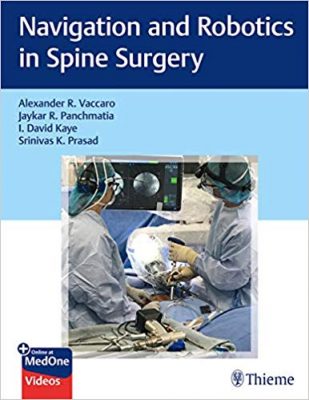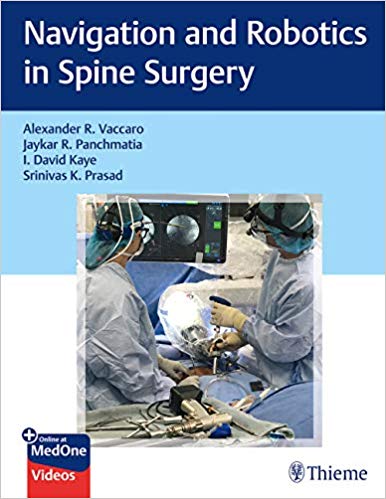 Editors: Alexander R. Vaccaro, MD; Jaykar R. Panchmatia, MA; I. David Kaye. MD; and Srinivas K. Prasad, MD
Editors: Alexander R. Vaccaro, MD; Jaykar R. Panchmatia, MA; I. David Kaye. MD; and Srinivas K. Prasad, MD
Publisher: Thieme – 211 pages, with 125 illustrations
Book Review by: Nano Khilnani
The specific aim of this book is to fill the need for techniques-based knowledge in the use of robotics in spine surgery. While robotics in itself is a relatively new method in surgeries of all kinds, and has many advantages over traditional surgery, its use is still not widespread because of the challenges posed by what is often referred to as a ‘learning curve’, both in knowledge and practice of the do’s and don’ts specific to spine surgery.
The editors express optimism: “As these technologies become more mainstream, early adopters are paving the way for more widespread adoption and navigated and robotic systems are now routinely found in community medical centers.”
They point out the following facts to support their optimism:
- In 2016, the robotics industry market was worth $4 billion, and is expected to grow by 75 percent to almost 75 percent to $7 billion by 2026
- The robotics market in spine surgery is expected to grow in turn, expanding the current (2020) market capitalization of approximately $75 million to $320 million by 2026
But some considerations need to be taken into account before these new technologies are widely accepted.
The editors explain: “However, several barriers to broader acceptance exist.” We itemize them below, using the exact their exact words in the Preface:
- Increased upfront costs
- Intrusion on the current workflow
- General lack of understanding of precisely how these technologies can enhance the surgical experience and potentially improve patient outcomes
We believe these barriers will be overcome, for the benefit of both spine surgeons and their patients, as knowledge and practice increases.
The publication of this book is a concrete example of how that knowledge and practice is spreading. Eighty-eight specialists in neurosurgery, orthopedics, orthopedic surgery, and spine surgery from all over the United States and five other countries – Canada, China, Italy, Japan, and the United Kingdom – authored the 34 chapters of this book that provides a look at the use of robotic techniques in spine surgery. We name the chapters below to provide you an overview:
- Part I – Introduction to Navigation and Robotics
- Principles of Navigated pedicle Screw Placement
- Three-Dimensional Computer-Assisted Navigation platforms
- Intraoperative Ultrasound in Spine Surgery: A Versatile and Useful Adjunct
- Magnetic Resonance Imaging-Based Navigation
- Shared Control Robotics
- Telesurgical Robots
- Supervisory-Controlled Robotics
- Radiation Exposure and Navigated Spinal Surgery
- Part II – Techniques for Navigation-Assisted Spine Surgery
- Outcomes in Navigated Spinal Surgery
- Navigated Subaxial Cervical Spine Pedicle Screw Instrumentation
- Navigated Anterior Transoral Surgery for C1 and C2 Pathologies
- Navigated Posterior Correction of Pediatric Scoliosis
- Navigated Posterior instrumentation of the Arthrodesed Spine
- Navigated Minimally Invasive Transforaminal Lumbar Interbody Fusion
- Robotic Instrumentation for Lumbosacral Spondylolisthesis
- The Role of Navigation in the Resection of Primary Spinal Tumor
- Surgical Management of Thoracolumbar Spinal Metastases Using Navigation
- Navigated Pelvic Fixation
- Navigated Sacroiliac Joint Fusion
- Navigation Balloon Kyphoplasty
- Part III – Techniques for Robotic-Assisted Spine Surgery
- Outcomes in Robotic Spinal Surgery
- Robotic Subaxial Cervical Spine Pedicle Screw instrumentation
- Navigated and Robotic Anterior Odontoid Peg Fracture Fixation
- Navigated and Robotic Posterior Atlantoaxial Fusion
- Robotic Posterior Thoracic Pedicle Screw Placement
- Robotic Minimally Invasive Transforaminal Lumbar Interbody Fusion
- Robotic Anterior Lumbar Interbody Fusion
- Part IV – Techniques Using Alternative Modalities for Complex Spine Pathology
- Intraoperative Ultrasound-Guided Intradural Tumor Resection
- Stereotactic Radiosurgery for Treatment of Primary and Metastatic Spinal Tumors
- Part V- Easing the Transition to Technological Adoption
- Operating Room Design and Efficiency
- Mounting the Learning Curve with New Technologies
- Part VI – Future Directions
- Artificial Intelligence
- What We Can Learn From Other industries
- Future Growth in Navigated and Robotic Spinal Surgery
This book is an admirably pioneering effort of 88 people in six countries to not only make the lives of people better using emerging navigation and robotic technologies in spine surgery, but to pass on to their colleagues around the world on how to do so, with their gems of information and insight found in this book. Kudos to the brilliant editors and authors!
Editors:
Alexander R. Vaccaro, MD, PhD, MBA is the Richard H. Rothman Professor and Chairman of the Department of Orthopedic Surgery, Professor of Neurosurgery at Thomas Jefferson University and Hospitals, and President of the Rothman Institute in Philadelphia, Pennsylvania.
Jaykar R. Panchmatia, MA, MPH, MB BChir, FRCS is Consultant Spine Surgeon at Guy’s and St. Thomas Hospitals in London in the United Kingdom.
I David Kaye, MD is Assistant Professor of Orthopedic Surgery at Thomas Jefferson University and Hospitals, and Spine Surgeon at the Rothman Institute in Philadelphia, Pennsylvania.
Srinivas K. Prasad, MD, MS is Associate Professor of Neurological Surgery, and Director of the Neurological Spine Fellowship at Thomas Jefferson University and Hospitals in Philadelphia, Pennsylvania.







